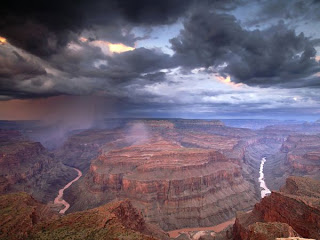We’ve all heard of at least one of the Seven Natural Wonders
of the World, but many of us have never seen the complete list. We thought it
would be fun to share all seven with you.
Northern Lights
Also known as the Aurora Borealis or polar auroras, the
Northern Lights look like a glowing wave of colored light dancing across the
sky at night. They are seen in the Northern Hemisphere, and in North America,
the best vantage points are in Alaska and Canada during spring and fall months.
The Lights are fascinating to watch because they fluctuate in size, color, and
movement each night. However, this unpredictable behavior also means you don’t
know when or for how long they will appear.
An intriguing phenomenon causes the Northern Lights. As the
sun burns, it continuously releases charged particles into space. As this solar
wind of particles approaches the earth, it is attracted by magnetic fields to
the earth’s poles. As the particles reach the upper atmosphere at high speed,
they collide with the gases that surround the earth. These collisions emit light,
and the type of gas involved in the collisions determines the color of the
lights: green is oxygen, blue is nitrogen, and red is hydrogen.
The South Pole has its own polar auroras known as the Aurora
Australis or Southern Lights.
Harbor of Rio de
Janeiro or Guanabara Bay
The largest bay in the world, the Harbor of Rio de Janeiro
was created by erosion from the Atlantic Ocean. The granite and quartz mountain
formations surrounding the harbor rise straight from the water’s edge. The
famed Sugarloaf Mountain is a striking feature of the harbor’s peninsula, and for
panoramic views of the harbor, take the cable car from Urca Hill to the top of
the mountain.
In the early 1500s, Portuguese explorers named it Rio de
Janeiro (first of January in Portuguese) because they believed they had reached
the mouth of a great river on New Year’s Day.
Grand Canyon
Almost 300 miles long, up to 18 miles wide, and one mile
deep, the Grand Canyon is a spectacular gorge in northern Arizona. Carved by
the Colorado River millions of years ago, its massive size, stunning landscapes,
and geologic beauty make it one of the world’s natural wonders. The South Rim
offers several amazing vantage points, but for the most magnificent views,
you’ll need to make your way along the dirt path to the Toroweap Overlook or
brave the Grand Canyon Skywalk.
Located at the west rim of the canyon, the skywalk is a
glass bottomed, U-shaped observation deck that sits 70 feet past the canyon’s
rim and 4,000 feet above the Colorado River. Completed in 2007, the Skywalk is
part of the Hualapai Indian Reservation and gives you an unfettered view of the
canyon, though walking over the Grand Canyon on glass is not for the faint of
heart. The Hualapai tribe also offers shopping, dining, and outdoor song and
dance performances at the Skywalk.
Love this post? Share it with your
followers on Twitter.




No comments:
Post a Comment